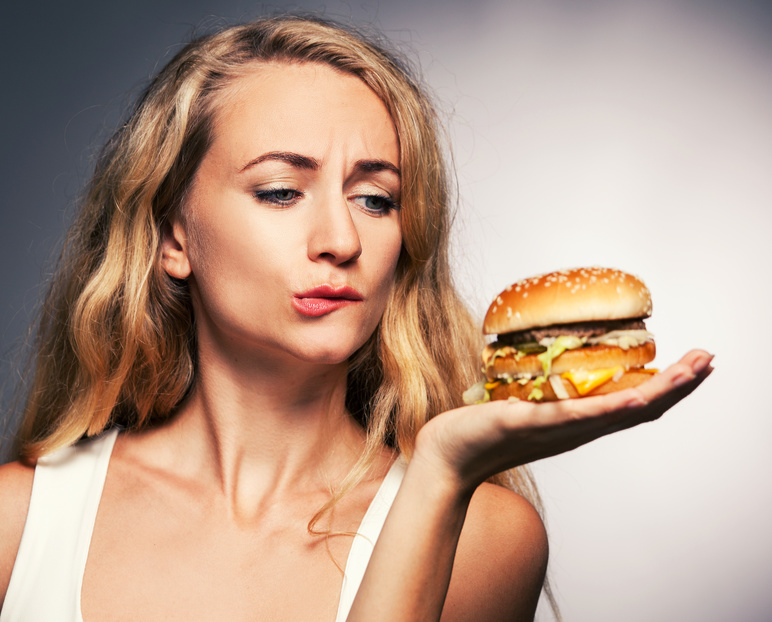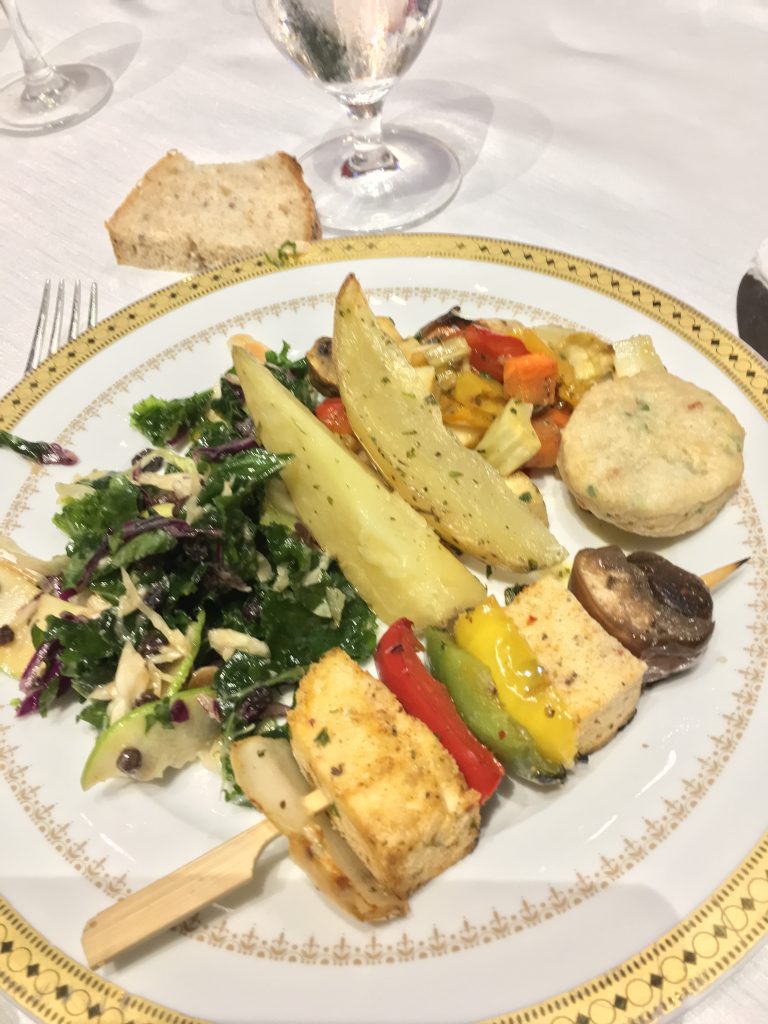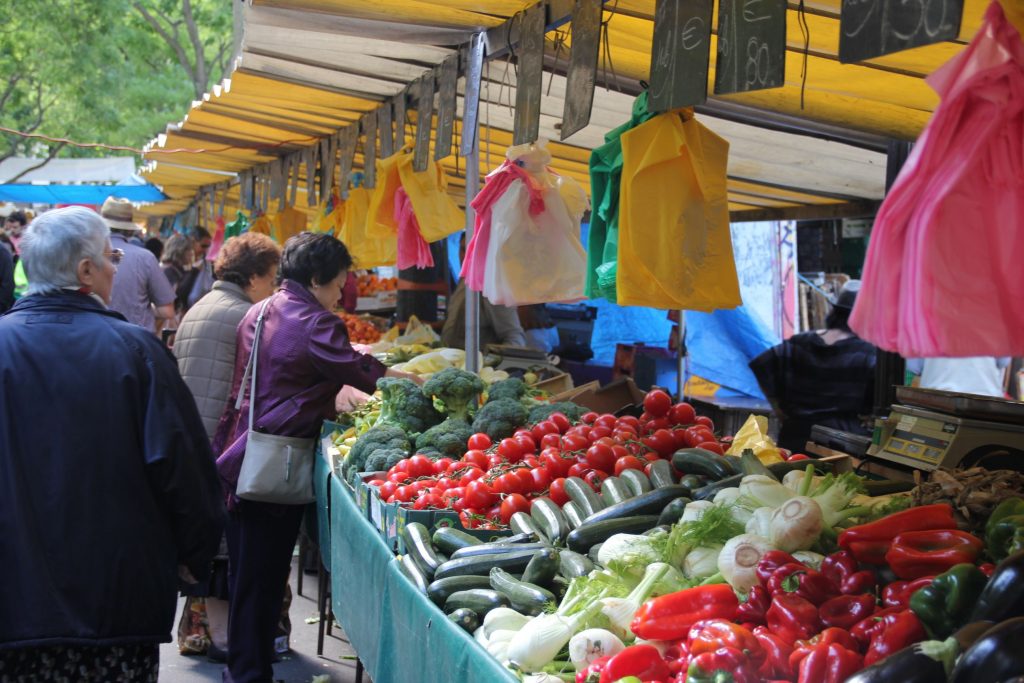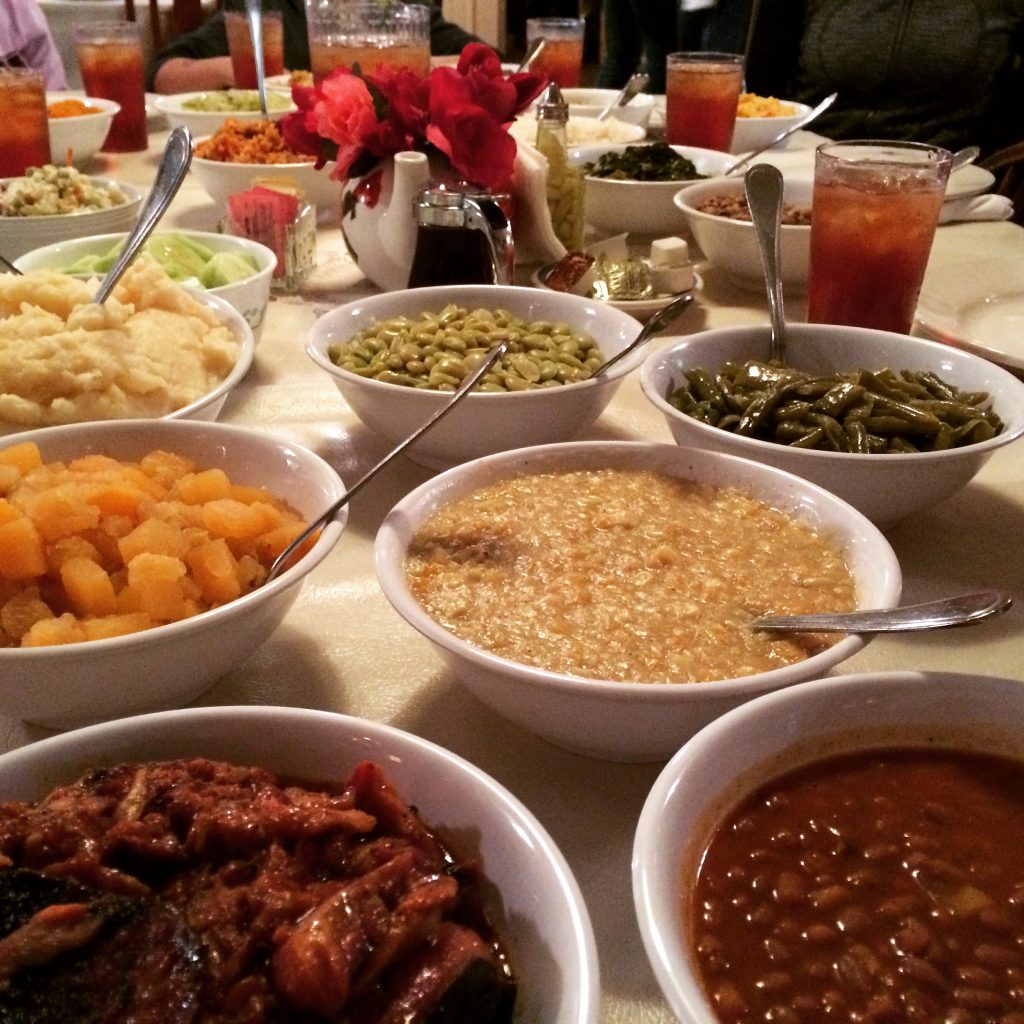
American food is in a crisis, states economist Tyler Cowen. Many Europeans agree that American food has problems: massive portions, excess fat, high levels of sugar, or any combination of those. But, is food in the US really so bad?
Last Friday, at my daughter’s graduation ball, among many highlights, the food turned out to be excellent. We enjoyed fresh rustic breads, exquisite kale-almond salad, grilled beef kabobs, and delicious roasted vegetables. As we ate, I commented on the porcelain dinnerware coupled with linen napkins and heavy silverware. My German table neighbors reacted similarly, praising the venue and the food.

French people can talk for hours about food, and I don’t know a single French person living in the US who doesn’t complain about American cuisine in some way. Personally, I dislike the stereotypical burgers and chicken nuggets, and I prefer using silverware while sitting at a table. But, believe me, American food is not as bad as many foreigners want us to believe.
In my opinion, if you shop and cook for yourself, you have a pretty good chance of eating well in the US. My friend Alexandra lived in Amsterdam before relocating to Washington, DC. When I asked her how she feels about American food, her first response was, “After living in the Netherlands, believe me, I LOVE American food!”
Of course, there are legitimate complaints about many types of American food. Fruits and veggies look wonderful in the supermarkets but have hardly any flavor. It’s really difficult to avoid sugar, honey, or high-fructose syrup in processed food, and even bread isn’t immune to fueling the nation’s sugary addiction. Food coloring is everywhere, and meat often shrinks to half its size once it’s in the pan. Why is this the case?
5 reasons why American food deteriorated
American economist and food lover Tyler Cowen has strong opinions about the declining food quality in the US. In his book entitled An Economist Gets Lunch, he dedicates a complete chapter to this phenomenon, explaining why American food got bad. Unlike the standard theory that blames the expansion of the food-supply network, Cowen tells a story that starts with prohibition and WWII, moves to the education system, and ends with the rise of television in most American households.
Prohibition and WWII rationing
“National Prohibition brought catastrophe to most good restaurants … [that were] unable to make money without alcohol sales.” As a result, the best restaurants closed, and “expensive, high-quality food was hurt the most,” says Cowen.
During WWII, 6 million American women went to work for the first time. Most of them were married and had children while their husbands fought somewhere in the Pacific or Europe. According to Cowen, “Wartime rationing and scarcity made high-quality ingredients and careful cooking distant priorities. Fresh vegetables and fruits were often not available.”
Eventually, the need to ship food abroad triggered the development of the American canning industry. Interestingly, at the same time, France—which, along with Europe in general, was more immediately affected by the war than the US—turned instead to local production methods and personal gardens.
My maternal grandparents had a farm with cows, goats, and chicken. My paternal grandparents lived in a small town that was occupied by the Germans after 1942. My grandfather increased the cultivated surface of his garden, sold his produce on the black market, and bartered fruits and veggies for meat. The absence of mass transportation forced many French people to look for local solutions, which may explain the constant popularity of French farmers’ markets.

A war on immigration
My husband has a favorite anecdote: When you ask somebody anywhere in the world for a good restaurant, they will send you to their favorite local place. But, when you ask an American for a good restaurant, he or she will first ask what you like—Mexican, Chinese, Korean, Arabic, Italian, American—before giving you lots of options!
American food is immigrant food, states Cowen, and he complains that the restrictions on immigration have hurt American food significantly. Earlier immigrants have lost their recipes from home as they transitioned into more stereotypical Americans. “Cut off from their roots … immigrants were reduced by the promise of American household ease. They started buying canned goods, bottled ketchup, and frozen dinners and microwaves. Sometimes, they pursued these trends in excess to show they were “real” Americans,” explains Cowen.
The impact of children on food
Cowen speaks harshly about American parents who let their children dictate what the family eats. Prohibition made restaurants more child-friendly, but most children prefer predictable food. According to Cowen, “American adults have been especially willing to cater to the food preferences of their kids … but this damages dining quality for everyone. American parents produce, buy, cook, and present food that is blander, simpler, and sweeter.”
I don’t know if I agree entirely with the author. Some of our American friends have grown-up children, and I’ve had excellent meals at their homes. However, considering the menu of the cafeteria at my children’s school, I fully agree with Tyler Cowen about poor food choices for children in the US.

The dominance of television
Eating in front of the television became popular for many Americans in the 1950s, which expedited the development of food that’s quick and easy to prepare. According to recent studies, today, under 30% of Americans eat in front of the TV, but sales of frozen food are steady, reaching around $22 billion in 2016.
Another study from Packaged Facts testifies that “90% of consumers buy packaged frozen hot meal items for heating or microwaving at home, a share that is up substantially—15 percentage points—in just two years.” Over 60% of Americans buy frozen pizza, while 40–45% of households use frozen dinners or entrées.
American food is more than burgers and frozen pizza
My friend Margaret grew up in the US during the 1960s, when mothers often stayed at home, caring for their family and preparing home-cooked meals every day of the week. When she married and had children, she followed her family’s tradition and kept on cooking for her family. Today, she teaches her adult daughter about the legacy of healthy home cooking!
Honestly, my family members and non-American friends have a hard time adapting to American food habits. Personally, I think the hardest time is when we need to get lunch after hours of driving on the interstate. Gas stations with rest and service areas are rare. Fast food chains are often the only option for us, and there’s no room to sit at a table and order a meal.

Yes, many Americans love their junk food, but it’s also possible to eat well in the US.
In Savannah, a popular family-owned restaurant, Mrs. Wilkes’ Dining Room, offers Southern food every day with lines starting as early as 9:00 in the morning. There is no menu, and the dishes change every day depending on their availability.
Then, look at lobsters in Maine, locally grown fruits and veggies in California, rising farmers’ markets in many towns, and ethnic food trucks in larger cities. These are just a few examples of the many ways to experience good American food. My friend Alexandra’s favorites are pulled pork and cheesecake. I couldn’t agree more with her choices!
For more insights into American cuisine, just check out Tyler Cowen’s book. I think you’ll find it highly informative.
Photo credits:
– Woman with hamburger by Tatyana Gladskih
– Others: Catherine Rochereul-Portier





Just got back from Paris – have traveled to Amsterdam, Prague and London. The food in the states does taste very bland compared to the European countries I have visited. The cost of food over here is another problem – add in chemicals and additives and it’s no competition between our countries and theirs
“War on immigrants”
America has plenty of fly covered taco stands, disgusting schwarma trucks and fake chinese food places. None of this had helped anyone..the food is just is bland as ever. When someone says “oh hey this place they got the best food ever!” Generally it’s the same old slop with some new salty variation of sauce on top.
Its hilarious people think you need to import people from the 3rd world just to enhance flavor. If that were the case america would be a world renown for its culinary expierence.
Reality is people in china wouldnt touch our chinese food. Mexicans laugh at the stuff they sell to the locals.
No the problem is simply everything is grown for profit. So its grown for weight with no care all for flavor. Salt Water is literally injected into deli meat to make it bigger
I was “Googling” about what’s wrong with American food and stumbled upon your site. I’m Asian, migrated in the States for two years now. I do CrossFit but I’ve been struggling to gain. The main reason is I quickly get full. I do cook, I don’t eat burgers and pizza. The veggies have no flavor at all, fruits are extremely sweet. The chicken meat are unusually bigger. I’ve been thinking it’s the quality of their food that makes me bloated.
I don’t know, but fresh fruits and veggies from the supermarket stay fresh for WEEKS. If you ask me, that’s weird considering they are living organisms
For me, cuisine is directly tied to culture, and an appreciation for culture more specifically. America has lost it’s culture to the big box stores, fast food chains, and low quality junk imported from Asia. We now live in a country driven by consumerism and stimulation and not passionate about quality and experiences. Food is directly related as there is no passion for cooking, families simply “do not have time”, the restaurant choices are terrible with 90% of products coming off a truck that drove 300 miles or more. I digress…the simple fact os that our government has allowed artificial ingredients, large food manufacturing companies, fast food chains, big box stores, and big Pharma to dictate everything we put in our bodies unless you think outside the box and learn what real Whole Foods taste like and where to source them…(Whole Foods Market). We have failed our children in school along with everyone else by allowing toxic ingredients to flood the market legally. Many ingredients allowed in the United States are banned from other countries. America needs a wake up call, and it needs to begin with a shift to quality rather than quantity
I can hear your frustration! How do you shop and what do you cook?
American food is good for some quick comfort. But I see it the same way I see Chinese or Indian food – an unhealthy meal saved for a day when I cannot be bothered to cook.
I have very little regard for American food though, especially compared to Chinese and Indian cuisine. It’s very bland and full of far too many mixes of sweet and savory.
And it’s sad because the country has access to many ressources. Basically getting excellent food in the US shouldn’t be an issue.
Oui on peut très bien manger aux États Unis! Et pas seulement sur les côtes.
Il faut chercher un peu dans certains endroits, mais il y a toujours moyen de trouver au moins une salade.
À la maison, on cuisine. Et on mange ensemble, on discute, on savoure.
Quand on fait les courses, on part avec une liste, pour éviter de ramener des cochonneries (même si on succombe parfois à la tentation !).
Oui c’est possible, mais c’est vrai qu’il faut s’accrocher dans les coins perdus… J’ai des difficiles souvenirs de la route entre le Yosemite et San Diego !
But I love american food.
It’s may be because i a fitness frick and choose only healthy food… Ha Ha ha…
Fruit and vegetable quality is directly related to local production. The closer to the farm, the better the quality. The rise of the farmers’ market is helping improve the diet. Eating seasonally is another requirement. The greatest loss to the American diet, and apparently some other countries as well, is the local butcher. Having some proximity to more rural areas does offer fresh, free-range chickens, eggs, the occasional hog or goat, and cheeses. Even the rare “older” chicken. Otherwise, you are looking at vacuum packed primal cuts from factories and as a result of that, a dearth of bones for the best stock.
I don’t spend more than average, instead buying less but of greater quality, and savoring the difference. You have to love the town markets all over Europe, especially in France. America still has some catching up to do, but getting better all the time.
I share completely your recommendations. Thank you for taking the time to comment!
Well, it might meanwhile have the same choice as here in the US, however, the price for a mexican or japanese meal is much higher (actually too expensive). So you think twice if you really want to go to a Japanese or Mexican Restaurant in Europe…
Mexican restaurant are not cheap here either! Thank you for you lively comment.
I finally was able to read an enjoy this Blog about food in America. Very well written with lots to think about. My favorite selections were the menu from the elementary school and the photo of the graduation ball dinner plate.
Back to that school menu: and we wonder why American children are experiencing an epidemic of obesity? When I travelled to Europe, I felt embarrassment sitting in the airport with other Americans. We took up twice as much space as other travelers did in their seats. Sitting next to one of my fellow Americans on the plane was even more difficult…the seats on airplanes are not made to hold Americans in the sizes we are now. Notice I say “we” and not “they”….butter, bread, chocolate and pasta are my undoing.
The book I recommend covers many ideas of this blog. Personally, I think that American food has “terminated” fat and instead put sugar every where. American food is incredibly sweet. Bread is sweet, sauces are sweet, even salads are completed with cranberries or raisins. Nothing to say against that, but when the salad doesn’t taste anymore like salad but like cranberry… I don’t like it!
A French manager living in the States for years has written a best seller called “French Women don’t get fat”. Well, I’m not the best example of it but I’m deeply convinced that moving to Germany as a young adult is part of my problem, the other ones being my love for food and stopping to exercise !
I definitely like the variety of the American cuisine :)! Honestly, that’s something what I really miss in Europe as most of the restaurants are filled with Spaghetti, Pizza and Kebab dishes. Japanese and Mexican restaurants are too expensive and Indian and Chinese restaurants are rare in some parts of Europe. Here in the US you have a huge choice when it comes to restaurants.
I don’t know Evelyne… When I moved to Germany in 1989, there was German food or Italian (pizza or icecream), Kebab or Chinese. When I left in 2013, Germany was deeply transformed: over time came Thai, Japanese and Vietnamese restaurants, Tapas bars and Mexican food. German food today is pretty good, my problem there is more to find quality meat to affordable prices.